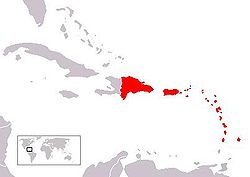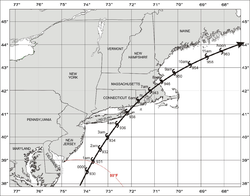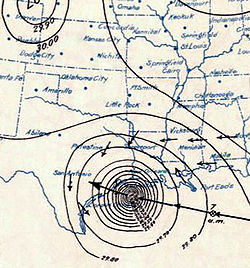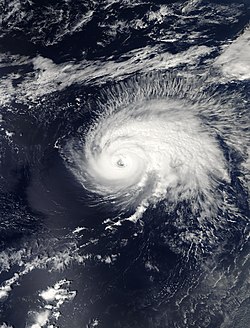Draft:Forgotten Hurricanes
This article has multiple issues. Please help improve it or discuss these issues on the talk page. (Learn how and when to remove these messages)
|
 2001 Hurricane Felix |
There are many forgotten hurricanes so i made a list of hurricanes oldest to newest and it goes from 1780 to 2006
Great 1780 Hurricane
[edit]
Main Article: Great Hurricane of 1780
The Great Hurricane of 1780 was the deadliest tropical cyclone in the Western Hemisphere. An estimated 22,000 people died throughout the Lesser Antilles when the storm passed through the islands from October 10 to October 16. Specifics on the hurricane's track and strength are unknown, as the official Atlantic hurricane database only goes back to 1851.
The hurricane struck Barbados likely as a Category 5 hurricane, with one estimate of wind gusts as high as 200 mph (320 km/h), before moving past Martinique, Saint Lucia, and Sint Eustatius, and causing thousands of deaths on those islands. Coming in the midst of the American Revolution, the storm caused heavy losses to the British fleet contesting for control of the area, significantly weakening British control over the Atlantic. The hurricane later passed near Puerto Rico and over the eastern portion of Hispaniola, causing heavy damage near the coastlines. It ultimately turned to the northeast and was last observed on October 20 southeast of Atlantic Canada.
The death toll from the Great Hurricane alone exceeds that of many entire decades of Atlantic hurricanes. Estimates are significantly higher than for the 1998 Hurricane Mitch, the second-deadliest Atlantic storm, for which figures are likely more precise. The hurricane was part of the disastrous 1780 Atlantic hurricane season, with two other deadly storms occurring in October.
1775 Newfoundland Hurricane
[edit]Main Article: 1775 Newfoundland Hurricane
The 1775 Newfoundland hurricane, also known as the Independence Hurricane, was a hurricane that struck the Thirteen Colonies and the Colony of Newfoundland in August and September, 1775, at the outset of the American War of Independence. It is believed to have killed at least 4,000 people, making it one of the deadliest Atlantic hurricanes of all time. There is disagreement among historians and meteorologists whether the events were one storm or two distinct storms.
1938 New England Hurricane
[edit]
Main Article: 1938 New England Hurricane
The 1938 New England Hurricane (also referred to as the Great Long Island - New England Hurricane and the Long Island Express Hurricane) was one of the deadliest and most destructive tropical cyclones to strike the United States. The storm formed near the coast of Africa on September 9, becoming a Category 5 hurricane on the Saffir–Simpson hurricane scale, before making landfall as a Category 3 hurricane on Long Island on Wednesday, September 21. It is estimated that the hurricane killed 682 people, damaged or destroyed more than 57,000 homes, and caused property losses estimated at $306 million ($4.7 billion in 2024). Also, numerous others estimate the real damage between $347 million and almost $410 million. Damaged trees and buildings were still seen in the affected areas as late as 1951. It remains the most powerful and deadliest hurricane to ever strike New York and New England in history, perhaps eclipsed in landfall intensity only by the Great Colonial Hurricane of 1635.
Great Colonial Hurricane of 1635
[edit]
Main Article: Great Colonial Hurricane of 1635
The Great Colonial Hurricane of 1635 was an extraordinarily powerful and devastating Atlantic hurricane that brushed Colonial Virginia and struck the New England Colonies in late August 1635. Accounts of the storm are very limited, but it was likely the most intense hurricane to hit New England since European colonization. The storm had a similar track and forward speed to that of the 1944 Great Atlantic hurricane and is the first of five known major hurricanes to have struck the modern New England region. The storm also likely produced one of the greatest storm surges in United States history, modern analysis has found.
Great 1900 Galveston Hurricane
[edit]
Main Article: 1900 Galveston Hurricane
The 1900 Galveston hurricane, also known as the Great Galveston hurricane and the Galveston Flood, and known regionally as the Great Storm of 1900 or the 1900 Storm, is the deadliest natural disaster in United States history. The strongest storm of the 1900 Atlantic hurricane season, it left between 6,000 and 12,000 fatalities in the United States; the number most cited in official reports is 8,000. Most of these deaths occurred in and near Galveston, Texas, after the storm surge inundated the coastline and the island city with 8 to 12 ft (2.4 to 3.7 m) of water. As of 2025, it remains the fourth deadliest Atlantic hurricane on record, behind Hurricane Fifi of 1974. In addition to the number killed, the storm destroyed about 7,000 buildings of all uses in Galveston, which included 3,636 demolished homes; every dwelling in the city suffered some degree of damage. The hurricane left approximately 10,000 people in the city homeless, out of a total population of fewer than 38,000. The disaster ended the Golden Era of Galveston, as the hurricane alarmed potential investors, who turned to Houston instead. In response to the storm, three engineers designed and oversaw plans to raise the Gulf of Mexico shoreline of Galveston Island by 17 ft (5.2 m) and erect a 10 mi (16 km) seawall.
1928 Ockeechobee Hurricane
[edit]
Main Article: 1928 Ockeechobee Hurricane
The Okeechobee hurricane of 1928, also known as the San Felipe Segundo hurricane, was one of the deadliest hurricanes in the recorded history of the North Atlantic basin, and the fourth deadliest hurricane in the United States, only behind the 1900 Galveston hurricane, 1899 San Ciriaco hurricane, and Hurricane Maria. The hurricane killed an estimated 2,500 people in the United States; most of the fatalities occurred in the state of Florida, particularly in Lake Okeechobee. It was the fourth tropical cyclone, third hurricane, the only major hurricane of the 1928 Atlantic hurricane season, and remains the deadliest disaster in Florida’s history to date. It developed off the west coast of Africa on September 6 as a tropical depression, but it strengthened into a tropical storm later that day, shortly before passing south of the Cape Verde islands. Further intensification was slow and halted late on September 7. About 48 hours later, the storm strengthened and became a Category 1 hurricane on the Saffir–Simpson hurricane wind scale. Still moving westward, the system reached Category 4 intensity before striking Guadeloupe on September 12, where it brought great destruction and resulted in 1,200 deaths. The islands of Martinique, Montserrat, and Nevis also reported damage and fatalities, but not nearly as severe as in Guadeloupe.
Hurricane Flora
[edit]
Main Article: Hurricane Flora
Hurricane Flora was an extremely deadly and devastating tropical cyclone that is among the deadliest Atlantic hurricanes in recorded history, with a death total of at least 7,193. The seventh tropical storm and sixth hurricane of the 1963 Atlantic hurricane season, Flora developed from a disturbance in the Intertropical Convergence Zone on September 26 while located 755 miles (1,215 km) southwest of the Cape Verde islands. After remaining a weak depression for several days, it rapidly organized on September 29 to attain tropical storm status. Flora continued to strengthen, reaching Category 3 hurricane status after moving through the Windward Islands and passing over Tobago, and it reached maximum sustained winds of 145 miles per hour (233 km/h) in the Caribbean.
Hurricane Gordon
[edit]
Main Article: Hurricane Gordon (2006)
Hurricane Gordon was the first tropical cyclone since 1992 to affect the Azores while retaining tropical characteristics. The eighth tropical storm, third hurricane, and first major hurricane of the 2006 Atlantic hurricane season, Gordon formed on September 10 in the tropical Atlantic Ocean. It gradually matured into a hurricane as it tracked northward, reaching its peak intensity with winds of 195 km/h (121 mph) early on September 14 while located about 925 km (575 mi) southeast of Bermuda. After becoming nearly stationary, Gordon weakened to minimal hurricane status, although it re-intensified after accelerating to the east. It weakened again after moving over cooler waters, and passed through the Azores on September 20. Shortly thereafter, it became an extratropical cyclone and subsequently affected Spain, Ireland, and the United Kingdom.
Hurricane Felix
[edit]
Main Article: Hurricane Felix (2001)
A tropical wave spawned a tropical depression on September 7 near the Cape Verde islands, which degenerated back into a tropical wave the next day due to strong shear. It redeveloped back into a tropical depression on September 10, and intensified into Tropical Storm Felix the next day while tracking generally northward. By September 13, it intensified into a hurricane, and subsequently it underwent rapid deepening, becoming a major hurricane on September 14 with peak winds of 115 mph (185 km/h). By that time, Felix had turned to the northeast, and subsequently entered an area of unfavorable conditions. The hurricane gradually weakened, deteriorating to a tropical storm on September 17. Cool waters and higher wind shear caused additional weakening while Felix nearly stalled to the southwest of the Azores. Late on September 18, the storm weakened to a tropical depression, and early the next day Felix dissipated.
Hurricane Rita
[edit]
Main Article: Hurricane Rita
Hurricane Rita was the most intense tropical cyclone on record in the Gulf of Mexico, tying with Hurricane Milton in 2024, as well as being the fourth-most intense Atlantic hurricane ever recorded. Part of the record-breaking 2005 Atlantic hurricane season, which included three of the ten most intense Atlantic hurricanes in terms of barometric pressure ever recorded (along with Wilma and Katrina), Rita was the seventeenth named storm, tenth hurricane, and fifth major hurricane of the 2005 season. It was also the earliest-forming 17th named storm in the Atlantic until Tropical Storm Rene in 2020. Rita formed near The Bahamas from a tropical wave on September 18, 2005, that originally developed off the coast of West Africa. It moved westward, and after passing through the Florida Straits, Rita entered an environment of abnormally warm waters. Moving west-northwest, it rapidly intensified to reach peak winds of 180 mph (285 km/h), achieving Category 5 status on September 21. However, it weakened to a Category 3 hurricane before making landfall in Johnson's Bayou, Louisiana, between Sabine Pass, Texas and Holly Beach, Louisiana, with winds of 115 mph (185 km/h). Rapidly weakening over land, Rita degenerated into a large low-pressure area over the lower Mississippi Valley by September 26.
1912 China Typhoon
[edit]
Main Article: 1912 China Typhoon
The 1912 China Typhoon was an extremely deadly tropical cyclone that devastated the coast of China on August 29, 1912. It formed in the Philippine Sea, before making its way to the China. The typhoon brought strong winds and substantial amounts of rain. Heavy flooding along rivers were reported in Zhejiang, resulting in 50,000–220,000 fatalities. It is one of the deadliest recorded typhoons in history.
Cyclone Bhola
[edit]
Main Article: 1970 Bhola Cyclone
The 1970 Bhola cyclone (also known as the Great Cyclone of 1970) was a catastrophic and extremely deadly tropical cyclone that struck East Pakistan (present-day Bangladesh) and India's West Bengal on 12 November 1970. It remains the deadliest tropical cyclone ever recorded and one of the world's deadliest humanitarian disasters. At least 300,000 people died in the storm, possibly as many as 450,000, primarily as a result of the storm surge that flooded much of the low-lying islands of the Ganges Delta. Bhola was the sixth and strongest cyclonic storm of the 1970 North Indian Ocean cyclone season.
Special Hurricane wiki pages made by others
[edit]
